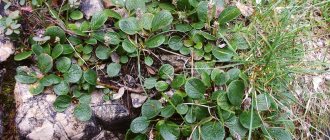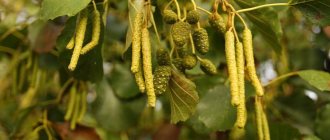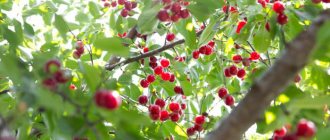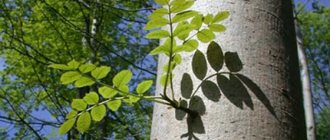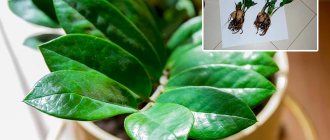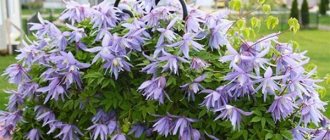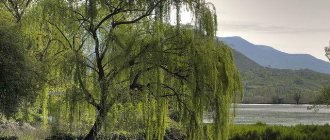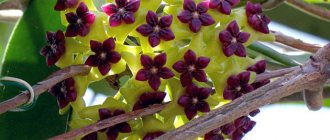Jacaranda or Rosewood tree is an evergreen tall and medium-sized tree belonging to the Bignoniaceae family. The genus contains about 50 species. They grow in the tropics and subtropics of South America, most often found in Brazil.
Why violet tree?
Due to its unusual appearance, jacaranda is called a violet tree and also a fern tree. Let's explain why. The maximum height of the tree is 20 m. The leaves are fern-shaped: pinnately dissected, arranged oppositely.
Jacaranda blossoms are incredibly beautiful. Large tubular flowers are collected in axillary or apical inflorescences. They are five-membered and dioecious. Color - various shades of blue, lilac, purple, white and purple are also found.
Jacaranda tree that gives beauty and brings good luck Jacaranda flowering photo
The jacaranda tree not only gives aesthetic pleasure, but also provides benefits. It is an excellent honey plant; the wood is also valuable: various types of parquet, expensive furniture, souvenirs, various luxury items and even musical instruments are made from it.
Photo gallery
Only mimosolia jacaranda can be grown indoors. It is better to keep it in rooms with a high ceiling, as it reaches a height of two meters. Jacaranda trees must be pruned before growing. More suitable for greenhouses and “winter gardens” than for a standard room in a Russian apartment.
It is non-toxic, does not affect air purification, and does not emit any harmful substances. Does not belong to the class of poisonous, not harmful to children, adults and pets.
Outwardly, it is often compared to sakura, jasmine and lilac. But in indoor conditions you will hardly find any flowering, so it resembles an ordinary plant with a beautiful stem and graceful leaves.
Usage
We have already mentioned that the valuable species of jacaranda wood is highly valued in the world. It is known as rosewood, which is used for the production of luxury furniture, unique luxury items (inlaid with metal and carved items). In addition, magnificent musical instruments are made from this wood.
When polished, the core of the wood becomes a beautiful brown with a purple tint. For example, in Brazil, you can see and buy jacarana souvenirs - carved figurines of exotic animals. They have a very pleasant delicate smell, especially when you wipe them with a cloth.
How does it bloom?
In wild conditions, jacaranda grows up to 15 meters, it has a lush crown and wide feathery leaves that have elongated bright green plates. The tree has large inflorescences with five dozen purple or bluish flowers with jagged calyxes and curved bell-shaped corollas, which are slightly lowered and bent.
Mimofolia jacaranda has violet-bluish inflorescences with small calyxes. The plant with flowers can be seen more often in October and early November. In indoor conditions, it blooms twice a year: in spring and autumn. Varieties of this species, Magdalena and Delta, are also used for cultivation.
Traditions and beliefs associated with jacaranda
In Australia, the jacaranda tree is very popular.
October-November - the end of the academic year on the mainland and the flowering of the fern tree are closely associated with student culture. Students even call it the exam tree because it is believed that if a blooming jacaranda panicle falls on your head, success in exams is guaranteed. The tree is believed to bring good luck.
An interesting tradition is to plant a plant with the birth of a child. In the 30s and 40s, the city of Brisbane even officially distributed jacaranda seedlings in maternity hospitals. Grafton hosts a festival dedicated to this beautiful tree every October.
Signs and superstitions
It is believed that jacaranda has a strong magical effect, so keeping it at home is extremely beneficial for the family. This is a tree that gives beauty and brings good luck. It has a number of properties that cleanse the aura and fill the space with positive energy.
It brings prosperity and prosperity. The violet tree purifies negative thoughts and instills harmony and tranquility in the soul. However, for some people it causes apathy and drowsiness.
According to Feng Shui, it is better to place jacaranda in wide spaces near windows. It is not advisable to place it next to the bed and resting place, in the kitchen or in the office.
Signs associated with the flowering of the violet tree are also common. This process promises well-being, brings prosperity to the house and may indicate an imminent addition to the family.
When purchasing a plant, pay attention to your interior. Jacaranda cannot be in a cramped and narrow space; it needs space. Don’t forget to move it into the shade in hot weather, otherwise the leaves may soon turn yellow.
When purchasing, pay attention to the leaves - if they are yellowish at the edges, and the leaves themselves are slightly curved, then this plant may soon wither.
Choose a violet tree with bright green leaves that have a glossy sheen.
Jacaranda tree: application in design
A jacaranda tree grown from seeds at home rarely blooms, so you can’t count on it to bloom. It is used as an ornamental plant, whose lush, openwork crown looks great even without inflorescences.
Jacaranda as Bonsai
The peculiarity of the flower is that it sheds its foliage in winter, and with age it begins to completely get rid of it in the lower part of the trunk, which gradually becomes woody. Professionals have learned to use this characteristic feature for decorative purposes, creating bonsai from jacaranda. With proper pruning, a lush bush transforms into an incredibly beautiful, discreet bansai.
Is Jacaranda suitable for bonsai?
The plant is used for cultivation using Japanese bonsai technology. This allows you to control the growth of the crown and leaves, as well as create your own miniature garden. There is even a separate variety of jacaranda, “Bonsai Blue,” which does not reach a length of more than 75 centimeters. For cultivation, the following conditions must be met:
- in the first year you cannot prune it;
- in the second year, cut to 10 cm and wait for side shoots to appear;
- then pinch the jacaranda, trimming the leaves and crown;
- to form the crown, you can use soft wire, which must be removed after 3 months;
- It is better to cut off all large leaves;
- Jacaranda will branch worse when standing in the shade.
Interesting facts about jacaranda
The fern-leaved jacaranda (Jacaranda filicifolia), like some other species of this genus, is valued for its very expensive wood and is known as rosewood or rosewood (palissandre). The core of this wood has shades ranging from dark reddish to chocolate brown with the addition of a violet tone, the sapwood (outer young layers of wood) is light yellowish. Rosewood wood is distinguished by its heaviness, strength and good polishing qualities; often this highly valuable material was used only in the manufacture of expensive furniture, musical instruments or colored parquet, and some turning crafts. Interestingly, with today's technologies it is possible to successfully imitate rosewood wood, while using less valuable tree species such as birch, maple or alder. Many of the varieties, such as Jacaranda mimosifolia, are most often cultivated due to their high decorative value, as a garden plant; some species can be grown as an indoor crop. Since on the Australian continent the time falling in October and November is the end of the school year and exam time, and at this time the process of flowering of the jacaranda begins, the violet tree is called the exam tree. There is even a superstition among local students that if the panicle inflorescence of a rosewood tree falls on your head, then all exams will be successful. However, with large numbers of jacaranda trees planted, this is a frequent occurrence, and there is a belief that this plant brings good luck. But some pessimistic students call this beautiful tree “lilac panic”, because when it blooms, the “hot time” for students begins. They even say that while the jacaranda is not blooming, it is too early to prepare for exams, and when it blooms, it is already too late. Also in Australia, it is customary to plant a rosewood tree after the birth of a baby; this tradition is so strong that maternity hospitals in the city of Brisbane in the 30-40s of the last century gave out seedlings to happy parents. In another city, Grafton, every October is marked by the Jacaranda Festival, with street processions and celebrations of the plant.
Sources
- https://agronom.guru/zhakaranda
- https://tutknow.ru/garden_and_orchard/7770-zhakaranda-sovety-po-vyraschivaniyu-i-razmnozheniyu-palisandrovogo-dereva.html
- https://chto-posadit.ru/derevo-zhakaranda-vyrashhivanie-iz-semyan-v-domashnih-usloviyah-uhod-i-razmnozhenie-foto-vidov/
- https://komnatnie-rastenija.ru/zhakaranda-vyrashhivanie-i-uhod-v-domashnih-uslovijah-foto-vidov/
- https://pocvetam.ru/komnatnye-rasteniya/derevjya-i-kustarniki/dzhakaranda-fialkovoe.html
[collapse]
Home care
In summer it is unpretentious and easily adapts to the absence of sun, and in the heat it practically does not dry out. It is recommended to keep it at a temperature of - 13 °C. In winter, it needs a cool room, with a temperature of about 7 °C. Sudden changes in temperature are not allowed, as the plant is in “hibernation”.
High humidity of at least 60% is desirable; daily spraying with soft water at room temperature is required. In winter, you need to water less often, up to once every 3-4 weeks.
The violet tree loves light, so it can be placed in a window all day. Young plants can exist in light partial shade. In winter, additional light sources are needed.
A large clay pot is suitable for planting. Jacaranda must be spacious, it is necessary that there is room for further growth. If the tree grows a lot, it needs to be transplanted into a larger pot. It is recommended to use containers made of natural materials (clay, ceramics).
Growing from seeds
The seeds are first soaked in water, to which stimulants are first added (“Ribav-Extra”, HB-101, “Epin”, “Zircon”, etc.). The seeds should be kept in this solution for 5-6 hours. After this, they are sown in light, loose, moist soil (depth - no more than 1 cm). Germination occurs at a temperature of +23. +28 degrees, in the light, under the film. Shoots appear very quickly, after about 10 days, but sometimes germination takes up to three decades. It depends on their quality. Seedlings do not need to be planted until they are three months old, so the seeds should be planted in a fairly spacious container.
With good care, your tree will reach a height of 1.5 m. Jacaranda (violet tree) in Russia (you can see the photo in our article) is an indoor plant. In such conditions it blooms extremely rarely. Flowering species of this plant can only be seen in botanical gardens.
Transfer
To prepare a jacaranda for transplanting you need:
- treat the leaves with a protective spray and trim them;
- prepare a new pot and soil;
- add fresh humus to the soil;
- treat the soil with phosphates.
A transplant may be needed:
- after the purchase;
- because the flower has grown and the pot is cramped;
- due to improper soil;
- due to flower diseases.
Replanting during flowering is undesirable, but is possible only if the plant has been attacked by pests and are beginning to approach the root system.
Difficulties in cultivating jacaranda
If during the winter or spring months the leaves of the plant begin to fall off, then do not worry - this is a natural process of replacing old foliage with new ones. Rosewood wood can be affected by spider mites, scale insects, mealybugs or whiteflies. If pests or their metabolic products are identified, it is necessary to treat with insecticidal preparations. Jacaranda is practically not susceptible to disease or fungal diseases. If the leaves begin to fly off for no reason, then the plant may have been exposed to cold air, a draft, or the soil may have dried out. If you do not water the substrate in a pot with a violet tree for a long time or moisten it with hard water, chlorosis may appear (the leaves will begin to thin out and the shoots will unnaturally lengthen). If the soil is poorly drained, this can cause rotting of the root system.
Growing and Reproduction
Jacaranda is grown in 2 ways:
- seeds;
- cuttings.
What needs to be done for good seed germination?
- Growing from seed requires good soil.
- It is necessary to choose suitable soil with proper drainage.
- Use small ceramic pots.
- The temperature during germination should be up to 30 °C.
- You need to stretch small cotton wicks through the drainage and lower them into a container of water.
- The top of the drainage should be covered with soil and a seed should be placed in the center.
- The seed must be sprinkled with a small amount of soil.
- The pot should be placed in a transparent plastic container with a lid or grown in a greenhouse.
- It needs to be exposed to the light.
It is necessary to spray as the soil dries using a spray bottle. Shoots appear after 2-4 weeks.
Propagation by cuttings
- Cut the stalk.
- Dry it for several days in a pantry or other dry, dark place.
- Place in a heteroauxin solution for a day to accelerate root formation.
- Add moist substrate to the planting site.
- Plant the cuttings at an angle of 45 °C, adding peat and fine sand to the mixture.
- Cover with film and keep at 25°C.
Propagation of jacaranda by cuttings
Propagation of jacaranda by cuttings photo
Carry out cuttings from late spring to mid-summer. Cut apical or stem cuttings about 8 cm long, treat with root. Plant in a moist peat-sand mixture, cover with a cap and maintain the air temperature at least 25 ° C. Plant the rooted cuttings in separate containers.
Cuttings of jacaranda in water photo
Jacaranda cuttings also take root well in water: keep them in the root solution for the first day, and then place them in clean water. The roots will appear soon. When the roots are 1-2 cm long, plant new seedlings in separate pots.
Fertilizer and feeding
The best “nutrients” are fertilizers based on phosphorus and superphosphate. It is also recommended to use lime, but it should not be combined with acidified soil and alkaline fertilizers. It is better to use fertilizers in dry form, but you can add a little con class=”aligncenter” width=”1200″ height=”1200″[/img]
Organic
Manure, bird droppings, peat, silt, sawdust and tree bark, green manure, composts.
Mineral
They are considered excellent assistants when processing plants, strengthen them and provoke rapid growth.
- Potassium.
- Phosphorus.
- Complex mineral fertilizers.
You can buy mixtures of peat and sand, compost, as well as various mineral fertilizers. Among them: “Superphosphate”, “Ammophos”, “Urea” and others.
Kornevin is a cream-colored powder, a small amount is used in dry form, suitable for dipping the end of the cutting when transplanting for better rooting or rapid development of roots.
Heteroauxin is the main phytohormone of plants, promoting active metabolism and preventing rapid leaf fall.
You can prepare fertilizers at home by mixing natural ingredients with mineral ones.
It is necessary to feed during growth once every 2 weeks. It is very useful for jacaranda to use organic fertilizers, alternating them with mineral ones even during the dormant period. Watering
Water the jacaranda sparingly, as it does not like excessive moisture. It needs abundant watering during the period of active growth - from spring to autumn. The water should be at room temperature and soft; do not water it with cold water, as the violet tree may “get sick.” In winter, you need to water less often, and in especially cold months, up to once every 3-4 weeks.
Jacaranda - a tree that gives beauty and brings good luck
Jacaranda - a genus of these giant, unusually attractive flowering trees and shrubs, has about fifty species, it is located in the Bignoniaceae family.
Where does jacaranda grow? The native places of these spectacular plants are considered to be the tropical rainforests of South and Central America, and more specifically Brazil. Here the largest jacaranda flower grows up to twenty meters high.
Of course, jacaranda grows not only on the American continent. For its unique beauty and delicate honey smell, it has become a favorite and has attracted the attention of many residents around the world. Jakarandastad is the name given to this bright colorful tree by the inhabitants of the Republic of South Africa, which is the main decoration of their capital. A huge number of jacarandas decorate public gardens, parks and even roads that lead to the city. In some areas of Africa, they believe that the beautiful jacaranda emits a blue spirit, which, in controversial situations between people, helps to make the right decision.
It is possible that distant Australia is considered the second home of the jacaranda. After all, the climate of this area is very suitable for beautiful trees. In addition, Australians are very sensitive to this beautiful plant. Moreover, they support and honor the traditions associated with blooming jacaranda. So, without fail, every family must plant a tree in honor of the birth of a child. Jacaranda is a symbol of the arrival of spring. In addition, the beginning of the flowering of jacaranda trees is a harbinger of Christmas, described in poems and songs.
And the most interesting thing is that the jacaranda in its Australian homeland is called the tree of knowledge. You cannot find a single educational institution in Sydney where jacaranda does not grow. For Australian students, she is a mascot and regulates exams. There are many signs and predictions according to which the wishes of young Australians will certainly come true. And every student must certainly catch a sprig of a blooming jacaranda, or it itself must fall directly on the examinee’s head even then. Hooray! The exam was passed successfully! Therefore, among students, jacaranda is a “lilac panic”.
The most interesting thing is that jacaranda blooms twice a year. The first time it was very abundant and colorful. After flowering, the blue flowers fall off, forming a fluffy, bright and uniquely beautiful mat on the ground. Every lover of beauty would like to see this unique grace, because it is positive emotions and a good mood. This is never forgotten.
The jacaranda tree has huge, oppositely arranged, feathery, lacy leaves that resemble those of mimosa and fern . Panicles of purple and blue inflorescences grow on the tops of branches or emerging from the axils of leaves.
You can also find other names for the plant - jacaranda violet tree, fern tree. What is the appeal of this amazing plant? Of course, a blooming jacaranda or violet tree is certainly a lilac miracle. I wanted to see this charming beauty at least once, playing with a riot of lilac, blue, purple colors with the accompanying delicate aroma of honey.
The violet tree is unique not only for its unsurpassed decorative effect, but also has found application in the national economy. That is why jacaranda is also called rosewood. Rosewood (Palissandre) is the name given to the wood of some tropical tree species. These include jacaranda. Various types of expensive furniture, parquet flooring, various souvenirs and luxury items, even musical instruments made from the most valuable jacaranda wood are widely popular.
The jacaranda plant is found in many botanical gardens and greenhouses, where it adorns them with its bright purple and lilac hue. Indoor jacaranda is very popular among flower growers due to its decorative value, because in the home environment it blooms very rarely. This species is the mimosifolia jacaranda, more about it in the following sections.
Diseases
Leaves curl and turn yellow
Possible reasons are dry air and soil, cold, drafts. It is recommended to inspect your jacaranda for pests. If insects are not found, you need to adjust the care and maintenance regime.
Leaf chlorosis
Develops due to high lime content in the soil, poor watering, deficiency of iron, magnesium, sulfur and zinc. Accompanied by yellowing of leaves and slow growth. They are transplanted into nutritious soil and fertilized with fertilizers with a high content of missing microelements.
Root rotting
Lack of drainage, dense soil, excessive watering. Check the condition of drainage and soil. If necessary, replant the plant, stop watering, then water moderately.
Plant care
The violet tree is unpretentious in care, in this case the rule of the “golden mean” works. In the summer, the optimal temperature regime for keeping it is +20 – +25 degrees; for the winter, the dormant period, the tree sheds its leaves; 15–19 degrees of heat is enough for it.
Jacaranda needs bright light for short periods of time (up to three hours daily). For young animals it is enough to be in partial shade. In winter, bright light is especially important for the flower.
The plant prefers moist air, so it should be constantly sprayed with soft water from a spray bottle . During extreme heat and dry conditions, the jacaranda should be placed in a wide-bottomed tray filled with wet expanded clay so that water does not enter the pot.
Watering
The plant should be watered moderately throughout the year. In spring and summer, it is necessary to moisten the soil more often than usual. Water so that the top of the soil in the pot has time to dry out, but does not turn into dust.
The plant is difficult to tolerate complete drying out and excessive moisture. Water for irrigation should be soft and settled.
When the soil becomes excessively dry, the jacaranda drops its leaves and needs watering.
With sufficient moisture, the plant raises its foliage. Prolonged stagnation of moisture provokes root rot, so good drainage is necessary.
Soil and fertilizers
The soil should be loose, light, not compacted, well drained, with a high concentration of peat. The soil is a mixture of turf soil (2 parts), sand or perlite (1 part), peat (1 part), humus (1 part), you can add coal. According to many gardeners, ordinary universal soil for indoor plants is perfect.
From April to August, rosewood trees should be treated with fertilizers that contain minerals and do not contain calcium.
Fertilizers need to be applied in small doses, but often. It is useful to alternate organic fertilizers with minerals.
Top dressing
Fertilizing should be carried out in the summer no more than once every two weeks with fertilizer without calcium salts. Special complex fertilizers for indoor plants are well suited. In the autumn-winter period, you should not feed the plant.
Diseases and pests
Basically, the plant is resistant to diseases and pests, and is almost not affected by bacterial and fungal infections. However, problems may still arise: spider mites, aphids, whiteflies, scale insects, and mealybugs attack.
The main pests are whiteflies and aphids. If the leaves curl and turn yellow, then fall off, and white-yellow spots have formed on the underside of the leaf, you need to look to see if whitefly larvae are visible on the underside of the leaves. This pest sucks the sap of the plant.
Aphids eat the tops of plants and young shoots. If no measures are taken in time , this pest will completely eat all the jacaranda foliage. To get rid of insects, the foliage should be treated with insecticides (fufan, actellik, agravertin and others).
Symptoms of white damage are crowded leaves, they turn yellow and fall off, the flower sheds its leaves due to lack of moisture, low temperatures, and strong drafts. Also, insufficient moisture or watering with hard water leads to chlorosis (shoots become unnaturally elongated, leaves thin out), poorly drained soil leads to rotting of the roots.
Transfer
Plants should be replanted as needed, when the root system completely fills the entire pot. If the tree is not transplanted into a larger pot, its height growth will stop. Every year, with the onset of spring, young individuals (up to three years old) are transplanted to a shallow depth in a pot 2–3 cm larger than the previous one.
Old jacaranda plants need to be replanted every 2-3 years. The soil mixture is made from leaf and turf soil, with the addition of sand and peat in equal proportions.
Pests
Whitefly
Green larvae are visually visible on the underside of the leaves. They leave behind a sugary discharge. The foliage curls, turns yellow and falls off. The pest is a small white midge. Spraying with insecticides is carried out every 3 days. The drugs Inta-vir, Actellik, and Fufan have proven themselves well.
Aphid
Primary lesions are found on young leaves, at the very tops of the shoots. The affected parts of the plant curl, become sticky, and the jacaranda gradually withers. It is recommended to spray with Derris, Actellik, and Fitoverm. If the number of insects is small, you can try treating the plant with a soap solution.
Jacaranda - where it grows and botanical characteristics
Jacaranda, according to the description, is a prominent representative of the bignoniaceae family. The genus of these plants is represented by 50 species of evergreen or deciduous trees.
It grows naturally in South America and Brazil. For the rapid development of a flowering violet tree, jacaranda requires climatic conditions of the subtropics and tropics.
Tree of high growth rate. Its height on average reaches 15-20 meters. Under the most appropriate conditions, the tree can grow up to 35 meters.
Lat. Jacaranda mimosifolia (photo)
The trunk is wide, straight, with a smooth surface. Covered with grayish bark.
The crown is wide and spreading. The foliage is dense. It grows very quickly. The bark on young branches and annual growths has a red tint.
The leaves are large, pinnately dissected. Their length is within 45 cm. The leaf lobes have an ovoid or elongated oval shape with a pointed end. Closer to the base they narrow slightly.
A tree leaf consists of 4-5 pairs of leaflets, the size of which gradually decreases towards the base. Externally, the leaves resemble the leaf blade of a fern or mimosa. They have a rich green color. They are placed on branches alternately and far from each other.
It blooms with racemose or paniculate inflorescences, the length of which reaches 45 cm. The flower of this tree is bisexual and zygomorphic. Its corolla is no more than 5 cm and has slight pubescence. The diameter of the five opened petals is within 3 cm.
The aroma of flowers is rich, but at the same time light and unobtrusive. Has sweetish honey notes.
The color of the flowers depends on the type of crop. The palette of shades is varied: violet, lilac, whitish, cream, purple. In some varieties, the flowers have small inclusions several tones lighter or darker than the main color.
It blooms, according to the description, twice a year, in the spring and autumn seasons. Blooms more profusely in spring. Duration within two months.
Many people are interested in what kind of harvest jacaranda produces. After flowering, the fruits ripen on the tree. They have the shape of a rounded pod or capsule up to five centimeters long. The color is light, brown. Inside they have four black seeds.
These parameters are typical for jacaranda, which grows in natural conditions. The sizes of decorative varieties are much smaller, and flowering is very sparse or completely absent.
How to care for violet seedlings
Caring for young jacaranda is based on the general principles of growing any seedlings:
- watering;
- feeding;
- dive.
Moisten the soil in a timely manner, and when the plants form a pair of true leaves, transplant them into separate (or deeper) cups. Now you can diversify the substrate and make it more nutritious. To do this, mix one part each of humus, sand and peat soil, and add two parts of turf soil. This soil will also be suitable for adult jacarandas for further transplants.
Varieties for growing in an apartment
There are about 50 species in nature. Only two varieties are adapted for apartments. Young plants are kept at home.
- Jacaranda jasmine. In another way it is called fluffy. The tree is tall and spreading. The foliage is light green, similar to jasmine leaves. In natural conditions it reaches 15 meters and blooms with purple flowers.
- Jacaranda mimofolia is more common at home. In an apartment it usually grows no more than 2 meters. The leaves are elongated, the flowers are purple and resemble bells. Breeders have developed several interesting varieties adapted for growing in an apartment. The most popular varieties are jacaranda Delta and Magdalena.
Important! The tree is characterized by rapid growth. Regular pruning is done to control growth.
A characteristic feature is the fall of leaves in winter or spring. Don't worry - this is a natural process. After some time, young leaves will appear.
Conditions for the development of jacaranda
- Lighting
. For normal health and growth, exotic plants must be exposed to bright, diffused light. In this case, some direct sunlight should be allowed. It is recommended to place the pot with the plant on the east and west windows. During midday summer hours, if necessary, you should practice shading the jacaranda. - Thermal regime
. The plant does not tolerate heat. The optimal air temperature for it is from spring to September +20º. In winter, the thermometer readings should be +15+16º, but not lower than +10º. - Air humidity
. Jacaranda requires a high moisture content in the air, and therefore the crop must be regularly sprayed with soft water at room temperature from a spray bottle, especially in the summer. It is also good to place a pot of exotic plants in a tray filled with wet moss or expanded clay. - Soil and container for planting
. The plant must be planted in a nutrient substrate consisting of 2 parts of light turf soil, 1 part of peat, the same amount of humus, river sand and leaf soil. It would be a good idea to flavor the soil mixture with crushed charcoal. There is good drainage at the bottom of a medium-sized pot.
Where is it used?
There are several ways to use this tree:
- The most popular use of the plant is for decoration . In the southern part of America and Europe it is used to decorate parks, gardens and streets;
- Valuable wood use for the manufacture of various furniture And wooden luxury items;
Kitchen furniture
Guitar made of jacaranda wood
Rosewood table (polysander)
Polysander box
- Due to its strength, wood easily polished . From the prepared material , musical instruments and parquet ;
- Widely used in medicine in South America. The plant is used to treat various infectious diseases. Flowers, fruits and leaves are used to prepare a mixture that helps the body fight infections. This medicine has no side effects.
Jacaranda is a beautiful tree with magnificent flowers. Proper care of it, taking into account all the features of maintenance and reproduction, will ensure the growth of a healthy tree, which will delight you with its blooming appearance every day.
